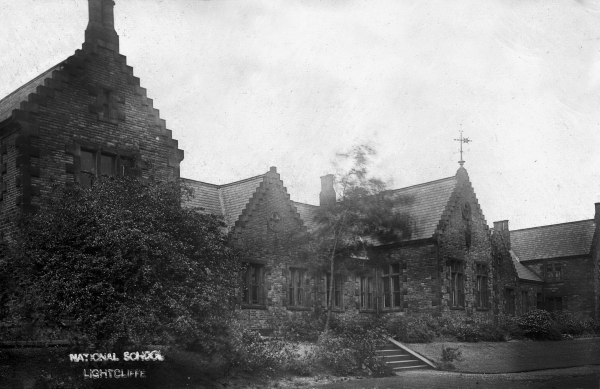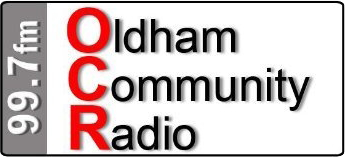The service was carried out by Reverend Kathryn Buck. With the present head teacher Charles Woodbridge gaving the opening reading this was followed by former head teacher John Brooke giving (the below) a short talk about the school. Three of the current students also read short stories from the school's history, which involving some of the students and teachers of the time.
On conclusion of the service refreshment were available which gave those attending the opportunity of reminiscing with some of the former students and teachers. Also in attendance was Brian Moore who was the school's caretaker for 37 years. There was a display of photographs which illustrated students and children dating back to the 1950s.
In March 1866 the Halifax Guardian announced that, following the apparent desire for learning by the people of Lightcliffe, that it was
A matter of urgent necessity that more school accommodation should be provided.
There were small elementary schools at Bramley Lane, established by Titus Salt, and at Coley. There was also, what was then a small grammar school, at Hipperholme.
How, though, readers wondered was this extra accommodation to be provided.
There was talk of a far reaching Education Act - what became the Forster act of 1870. W E Forster was a Bradford MP, a radical, a Quaker and a manufacturer. The act would see the establishment of Board Schools and a local rate. If, however, sufficient Voluntary schools existed, or could be provided, then a local board would not be imposed on the community.
Was it the augur of these so called 'religionless' schools, or just the Guardian report that resulted in the resident of the local mansion, Crow Nest, Evan Charles Sutherland -Walker to step forward? He had inherited the estate from his aunt Ann walker who died without issue in1854. Adding Walker to his Sutherland name was part of the deal.

Evan Charles Sutherland -Walker

Crow Nest Mansion c1920. Looking across at the conservatory with the house in the distance.
This was the home of Evan Charles Sutherland - Walker from 1854 until it was sold in 1867
What a deal it was £5000 (a monumental amount at the time) for the land and the fine buildings. Buildings that those passing on Wakefield Road today see them as they were 150 years ago with their Elizabethan architecture and rook stepped gables.
What excitement there must have been as the school took shape and, although education was not compulsory ( that was not until Mundella's Act of 1880, when it was still only so to the age of ten)
We read in the Halifax Courier in April 1869, two months after the schools opened, that
More than 120 children are on the schools' books. It appears that the parents of Lightcliffe appreciate the schools.
We do not know who those first pupils were as the admission registers to hand begin in 1885. The first entry is one George Jagger of Whitehall.
Names that follow are still in the locality today: Hoyle, Butterfield, Roper, Wilkinson, Longbottom, Taylor, Womersley, Greenwood, Midgley.
They came not just because they were Anglicans but because it was, and still is, a school for the community.
It was, of course, a National School (after the National Society for the Education of the Poor in the Principles of the Church of England) but ECSW clearly knew his audience and drew rapturous applause when he announced that at the opening ceremony that
No one will be compelled to learn the Church catechism
He wanted a school, though, where pupils would develop mentally, morally and religiously.
A church school in its community, then, proud to be linked to St. Matthew's but one that all the people wanted to be part of.
Generations of local people have attended the school. Great, great great, (even another great) grandparents of present pupils were the first pupils. Local people have supported the school through fund raising and still do ( this afternoon is an example) used the building or simply taken an interest in its life. People like a local primary school. Its that continuity that makes the school additionally special. ( mention my neighbour). Not just amongst the pupils but the staff also who have taught more than one generation.
Ethel Womersley, who from 1902 taught here for 45 years and more recently Jeanne O' Rourke and Derek Rooke for 36 and 35 years respectively.
When I returned as headteacher in 1984 (I began here in the early sixties) I was greeted as I walked through the playground with 'My grandma knows you'. A further example of the school's links through the generations
.
May 9, 1992 - John Brooke (second from the left) is photographed with some special visitors to the school
Admin staff, domestic staff and kitchen staff have served here for year upon year and Brian Moore, who retired in 2016, was caretaker for 37 years.
Finally the school has continued to fulfil Sutherland Walker's wish. It continues to value both the overt and the hidden curriculum. It is good that Norman Lister's family are here today for he introduced weekends away and mid-week residential visits that continue, and going back to 1923 we read that in George Hague's time, clearly for the time a visionary head, that
The school is especially successful in singing, drawing and physical culture

Norman Lister who was the school's head teacher for more than twenty years.
To paraphrase both Albert Einstein and B F Skinner
Education is what survives when everything you have been taught at school has been forgotten
Lightcliffe School has educated its pupils for 150 years.
A school in its community
A school firmly grounded in Christian values
A school for everyone
A school that, on a personal note, I have gained much satisfaction from being part of
A school that we can all be proud of.
John Brooke
Photographs suppled by Chris Helme





















